

spunwhirllin
-
Content count
201 -
Joined
-
Last visited
Posts posted by spunwhirllin
-
-
nothing here,go coco coir.
-
I received this as a macrogonus,it was kinda tore up when I got it.
As new growth presented itself it seemed as if it was going monstrose,then it partially variegated.
It grown quite a bit since the photo was taken,and it continues to exhibit the same oddball features.
Oddly enough two basal pups grew out normally until they reached 2 ''or so,then they also went variegated monstrose.
-
I'd have to agree Mel, the pups do indeed emerge in flushes.
I have a plant about the size of yours Mel,and it will always have a spring flush,a mid-summer flush and a fall flush.The number of pups gets larger annually as the plant gets larger itself.
The TBM are easily one the most interesting Trichs around,especially when you happen upon intermediate forms.
-
Hi Trucha,
Outstanding photos,the uyupampensis is a beauty.
The KK uyu's I have are still only 8'' tall,and really dont look like the one pictured,they appear to be cuzcoensis at this stage.
As far as defining macrogonus,I use the following.
6 + ribs,usually in the range of 8.
Spines that maintain a constant diameter,and reach a length of an inch,minimum.
Have red to black spine tips,(SUN EXPOSURE)that turn a light brown after a season.
One to two centrals,multiple radial spines,8 or so.
Slight curvature of the radials and/or centrals.
Chevrons above the areole are very slight to non-existent.
I would say heavy glaucous skin,but that truly isn't the case.
Above all else I apply familiarity and intuition,not very scientific,but......
As for peruvianus,I define these by simple deduction.
-
-
-
It seems we need to some comparisons in the culture of these plants.
With a few photos I can demonstrate the obvious morphological differences within the same plant.I have a few plants that maintain the original characteristics,while new pups that have matured under my care show startling variability.
I'll see if I can post a few photos.
Indicators for several of the coveted species seems to be fairly straight forward once you build a familiarity with the genus and accept the designations assigned to each.
My four year old son can pick out a macrogonus from bridgesii based on observable differences,once those differences are defined,I guess thats the trick.Yep,starting him off young.
What becomes complex is keeping up with all the cultivars,and hybrids out there.The only thing you can be sure of is what the tag states,and thats even risky.You certainly cant rely on physical descriptions anymore.
It must be the complexity that makes it so interesting,or annoying.
Osprey,
I've had good luck with crushed granite,consisting mostly of quartz and calcites,its a good source of minerals.Also crushed 1/4'' minus rock,which is sold by the yard.
There might not be a need to eliminate the organics all together if you just increase the mineral content.
-
-
Re: the moss drying out after being installed.
A syringe would work well to re-hydrate if need be.
For my phleb layer I used vermiculite and cocopeat,seems to maintain proper moisture content.
Yep,the first link is what instructed me,its a good one.
-
Thanks for all the info and advice.
Where does one find spagnum moss in the u.s.?
I cant source the stuff,I'll give it another go though.
Thanks again.
-
Hello all,
Well,I've been lucky,and persistent enough to obtain some fresh diplopterys seed.
Primarily I'm seeking some experienced advice on germinating these seeds.
I've had luck Banisteriopsis seed in the past,but rates are sporadic to say the least.
Typically,I use a sterilized fine grade peat/perlite seedling mix.
This mix works well for most seeds in general,but I'm treading unfamiliar territory with the diplopterys.
I never use fungicides,but could these seeds warrant its use?
Perhaps a quick dip into H202?
Suggestions and experienced advice would be much appreciated.
Thanks!
-
I decided to give the layering a go rather than striking a cutting,it seemed more likely to survive,than completely severing the branch.
Good to here the numbers of healthy plants are finally starting to grow.
Hopefully the chances of access to seeds and plants will increase.
I wouldn't say the plant enjoys re-potting,more like it tolerates it.
I have lost one plant to repotting,and the last time I re-potted, it dropped its leaves.
I re-pot in the spring,to ensure that its vigorously growing.This way,if it does drop its leaves it will quickly recover.
The current pot is 50 cm in diameter and 30cm deep.
I've been considering re-potting this season,but I'll wait till next spring.
If I dont get into the ground next spring I will go to a larger pot.
Looking at a 50 cm dia X 125 or cm deep.
I am concerned about rot issues with such a large pot though,probably need to put breathing holes in the sides of the pot as well as the bottom.
-
Thanks,
I am very fortunate and feel blessed for the oppurtunity.
As far as growing environment,I live in a valley surrounded by temperate rainforest.
Summers tend to get up into the high 90's F,with winters typically dropping into the twenties for four to six weeks,with alot of rain during the warmer parts of winter.I do keep the acacia in an un-heated greenhouse for winter,but release into the cruel world when the temps get into the 40's.
It will survive harsh winter cold,but when coupled with copious amounts of rain I fear that its roots would freeze.
I re-pot about every other summer using primarily granite gravel with lesser amounts of soil and compost.
Yes,a source for seeds would be really nice,I patiently await the fruits of my efforts from this Acacia,not like I have a choice.
However,its more likely that seeds of this plant will be available sooner from plants cultivated in Oz.
-
That is a beaut of a plant,the spination reminds me of something,i''ll take a quick look...
-
-
The epsom salt/grapefruit juice method has worked for my gallstones,instant relief.
These were true gallstones,they sat for a week and remained hard,and did contain calcified fats.
Malic acid is what you really want to try,this seems to break stones down slowly.
I've tried the phyllanthus in tincture and herb form.
The tincture is alright,but the herb is way to bitter,painfully bitter.
Just watch out for herbs such as dandelion and ginger that force the gall bladder to purge,this can cause stones to block the bile duct and cause the gall bladder to burst.
-
OOOH,so lucky.
Is this plant in the ground?
very nice.
-
Where oh where can this seed be had?
I've searched for years.
Anyone?
-
Thanks
It's a bit over 5 yrs now.
As the picture displays it was pretty much growing as a single trunked specimen,which really made me want to pinch the apical meristem to nudge along some branching out.
But I decided to wait,they're quite touchy.
About mid winter the A Meristem froze,Oh shit!,but it continued to grow and finally started branching in spring.
Sprouts started emerging from the base and pretty much all the way up to the tip.
Odd,but alot of the sprouts developed the seedling type bipinnate? leaves.
So it was doing well.
Then came time to re-pot,which was needed desperately.
So I found a pot 2' diameter by 2' deep and began to form a strategy.
How to repot without disturbing anything?
Luckily,the pot was plastic, so I cut around and across the bottom,like four pie pieces.
set everything in the new pot and gently slid the bottom pieces out,nice eh.
I made slits up the side walls of the pot and let em be.
Filled the new pot and over a course of a month gentily slid the sides of the old pot out.
Anal?,foolish?,overkill?,nah,worked beautifully.
New soil consists of about 80 lbs.of granite chips from 1mm to 25mm,pumice,a bit of sandy loam and a dash of compost.
And now the pot weighs about a hundred pounds.
If its alive it will be placed in the ground by the time its six,pretty much how Mulga suggests in his cultivation paper,on top of a mound of granite.
Fingers crossed for flowers and seeds.
-
Damn thats a beauty WR.
-
-
You guys are really going at it eh?
My humble,and simplistic interjection is this,
It will never be proven,nor disproven that this particular clone has been cultivated by the locals for thousands of years,period.
Artifacts from the Andes show without a doubt that these plants were used in ritual and were held in high esteem,as they are today.
I personally dont invest much in a few words written by a cactus vendor about a particular clone that they are trying to sell.
But I do choose to believe and invest faith in the notion that these cacti in general have been cultivated and tended to by man for thousands of years,if not longer.
Right or wrong,thats enough for me to carry on the tradition.
my 1 cent.
-
In terms of soil,crushed granite,pumice and loam seem to be the ticket,for me so far.
Does successfully raising a five year old phleb warrent the gifting of seeds
-
I suppose this question would be within the realm of ''preservation''.
My 5 yr old phleb is itching to give up quite a few cuttings,has anyone worked out whether or not cuttings are a viable means of propagation of phlebs?
I read awhile ago that its difficult,but it only takes one success to change everything,any success stories out there?
Airlayering softwood is probably going to be my first go.
Opinions?
Insights?
Thanks a bunch.
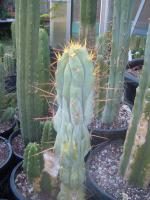
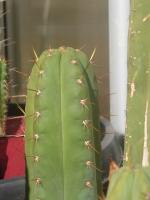

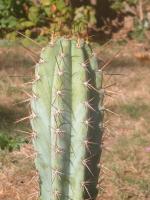
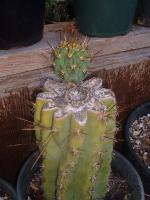

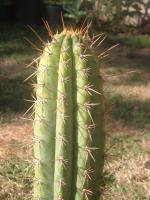
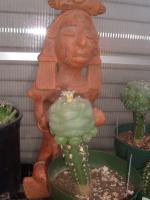

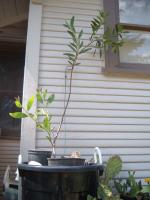
Peres Power Cord
in Cacti & Succulents
Posted
I have seen the results of rib grafting,and its OUTSTANDING!
Imagine four rooted pachanois,plugged into four ribs of a central pach.